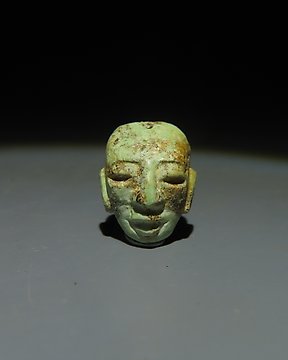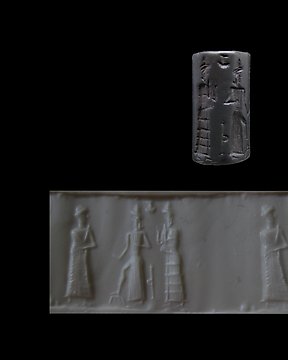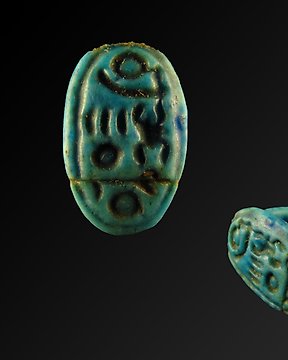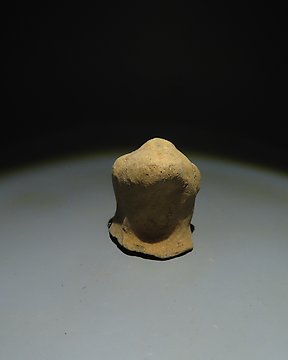Wunderbares Stück. Alles wie beschrieben. Hervorragender Kontakt.
Übersetzung ansehenAltägyptisch Stein SKARABÄUS-GÖTTIN HATHOR. 1,5 cm H. Beste Qualität. Ex. Antonovich-Sammlung.
Nr. 85409493


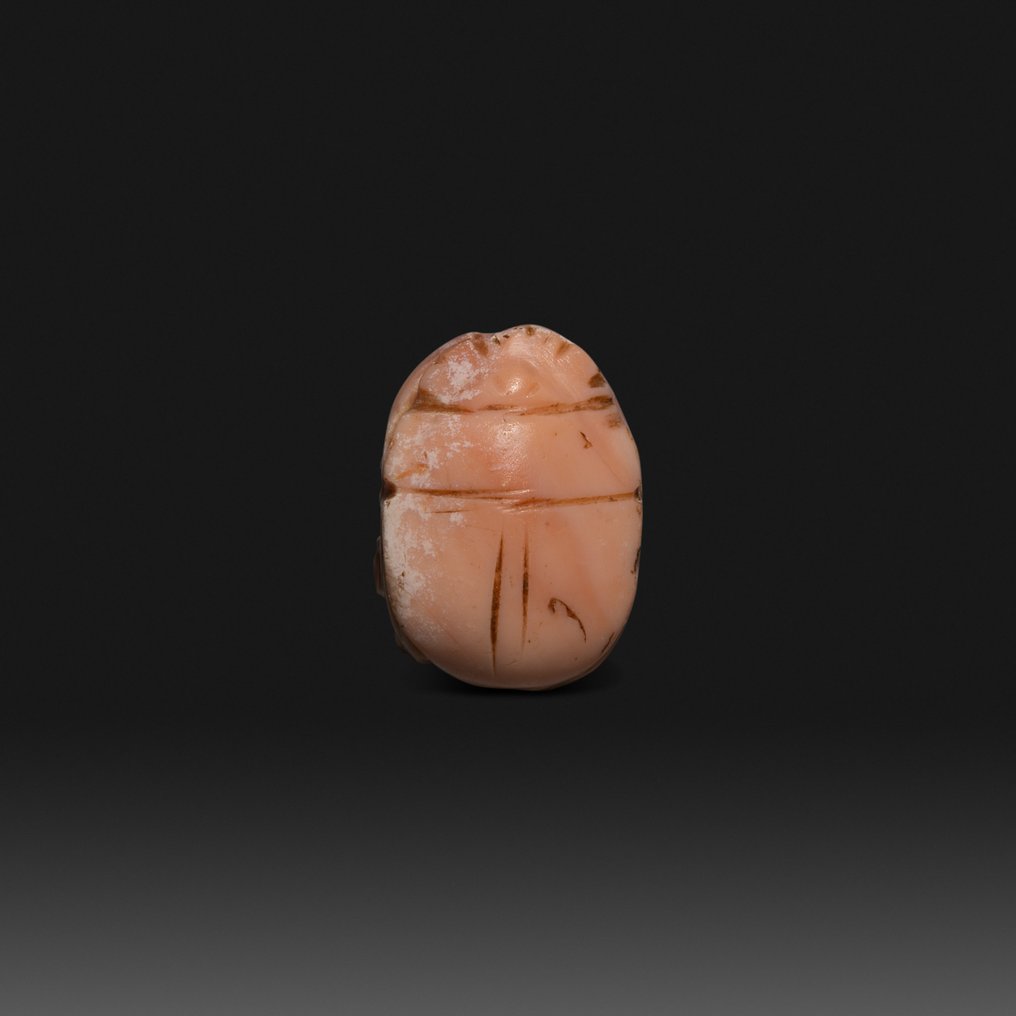
SCARAB WITH THE GODDESS HATHOR
- nice quality -
Ancient Egypt, Late Period, 664 - 323 B.C.
Stone
Height 1.5 cm
CONDITION: Intact.
PROVENANCE: Private collection, François Antonovich, Paris, France. Sold by judicial auction in 2022.
DOCUMENTS: Provided of a certificate of authenticity and export license by the Ministry of Culture.
Scarab-shaped amulet, called scarab, carved in carnelian. The upper part represents the animal in a naturalistic way, with the elytra differentiated and the head and legs reflected in detail. The scarab is placed on a flat base, decorated by incision and sunken relief with the image of the goddess Hathor identified by her characteristic headdress with cow horns. The deity appears seated in profile to the left with his torso facing forward, on a throne with a low back, in front of a vertical plant element. The image is framed by a simple oval line. The scarab is perforated longitudinally, which would allow it to be held with a cord or attached to a ring.
The scarab, a scarab-shaped amulet, is the most widespread form of Egyptian amulets both in the funerary context and in daily life. The oldest found, made of ivory, dates from the VI dynasty (c. 2345-2171 BC). The scarabs were represented in various materials: soapstone, basalt, granite and in precious stones such as lapis lazuli, amethyst, carnelian, and even in metals such as gold. In this case, in green jasper. They are generally small and pierced to allow them to be attached to a necklace, and at the base they carry a brief inscription or mythological, human or animal figures.
Symbol of the cycle of constant transformation of life, the scarab was linked to the god Jepri, form of Ra as the rising sun. The Egyptians believed that Jepri transported the Sun every day after its disappearance on the horizon, through the underground world or Duat, to make it reborn again the next day. The scarab was therefore an amulet of life and power, a representation of the rising Sun and a fundamental symbol of protection. Its importance has determined that numerous examples reach our days, which have allowed it to be studied in depth. In life, the scarab provided protection against visible and invisible evil, and daily granted strength and power to its possessor. In death, it granted the possibility of resurrection in the Afterlife and achieving eternal life.
In this funeral context, the so-called heart scarab stands out, which was placed on the chest of the deceased to protect his heart and even replace this organ if it was damaged in the mummification process. Used from the Middle Kingdom onwards, it soon became one of the most important amulets in the mummification process and funerary rituals. Starting at the end of the New Kingdom, when the heart scarab reached its greatest popularity, it began to be represented with wings, which symbolize the protection it offers. Other smaller scarabs were used in life individually or in groups, inserted in a pectoral collar structure, with the same protective function although not necessarily of a funerary type. These small scarabs also appear very frequently in rings of solar symbology, linked to the god Ra. On the other hand, a multitude of them have been found with the names of pharaohs inscribed on their base, often linked to the funerary temples of the characters they allude to but also used as protective amulets, which invoked the power of deified deceased pharaohs.
The use of amulets has been documented in Egypt as early as the Predynastic period, in the Badarian Neolithic culture (c. 4400-3800 BC). Inscribed lists have been found such as that of the Temple of Dendera or that of the so-called McGregor papyrus, where some 75 different models of amulets are cited with their form, function, meaning and signifier. They were symbolic objects that gave their possessor protection or power in the face of the world of chaos and in the journey to the Beyond. Through the word - key in ancient Egyptian culture - and appropriate rituals, the amulets were imbued with magical powers that gave them their protective function; They were therefore subjected to a kind of act of consecration that gave an inanimate object divine characteristics.
Notes:
- The piece includes authenticity certificate.
- The piece includes Spanish Export License (Passport for European Union) - If the piece is destined outside the European Union a substitution of the export permit should be requested, can take between 1-2 weeks maximum.
- The seller guarantees that he acquired this piece according to all national and international laws related to the ownership of cultural property. Provenance statement seen by Catawiki.
#alienscollection
Der Verkäufer stellt sich vor
SCARAB WITH THE GODDESS HATHOR
- nice quality -
Ancient Egypt, Late Period, 664 - 323 B.C.
Stone
Height 1.5 cm
CONDITION: Intact.
PROVENANCE: Private collection, François Antonovich, Paris, France. Sold by judicial auction in 2022.
DOCUMENTS: Provided of a certificate of authenticity and export license by the Ministry of Culture.
Scarab-shaped amulet, called scarab, carved in carnelian. The upper part represents the animal in a naturalistic way, with the elytra differentiated and the head and legs reflected in detail. The scarab is placed on a flat base, decorated by incision and sunken relief with the image of the goddess Hathor identified by her characteristic headdress with cow horns. The deity appears seated in profile to the left with his torso facing forward, on a throne with a low back, in front of a vertical plant element. The image is framed by a simple oval line. The scarab is perforated longitudinally, which would allow it to be held with a cord or attached to a ring.
The scarab, a scarab-shaped amulet, is the most widespread form of Egyptian amulets both in the funerary context and in daily life. The oldest found, made of ivory, dates from the VI dynasty (c. 2345-2171 BC). The scarabs were represented in various materials: soapstone, basalt, granite and in precious stones such as lapis lazuli, amethyst, carnelian, and even in metals such as gold. In this case, in green jasper. They are generally small and pierced to allow them to be attached to a necklace, and at the base they carry a brief inscription or mythological, human or animal figures.
Symbol of the cycle of constant transformation of life, the scarab was linked to the god Jepri, form of Ra as the rising sun. The Egyptians believed that Jepri transported the Sun every day after its disappearance on the horizon, through the underground world or Duat, to make it reborn again the next day. The scarab was therefore an amulet of life and power, a representation of the rising Sun and a fundamental symbol of protection. Its importance has determined that numerous examples reach our days, which have allowed it to be studied in depth. In life, the scarab provided protection against visible and invisible evil, and daily granted strength and power to its possessor. In death, it granted the possibility of resurrection in the Afterlife and achieving eternal life.
In this funeral context, the so-called heart scarab stands out, which was placed on the chest of the deceased to protect his heart and even replace this organ if it was damaged in the mummification process. Used from the Middle Kingdom onwards, it soon became one of the most important amulets in the mummification process and funerary rituals. Starting at the end of the New Kingdom, when the heart scarab reached its greatest popularity, it began to be represented with wings, which symbolize the protection it offers. Other smaller scarabs were used in life individually or in groups, inserted in a pectoral collar structure, with the same protective function although not necessarily of a funerary type. These small scarabs also appear very frequently in rings of solar symbology, linked to the god Ra. On the other hand, a multitude of them have been found with the names of pharaohs inscribed on their base, often linked to the funerary temples of the characters they allude to but also used as protective amulets, which invoked the power of deified deceased pharaohs.
The use of amulets has been documented in Egypt as early as the Predynastic period, in the Badarian Neolithic culture (c. 4400-3800 BC). Inscribed lists have been found such as that of the Temple of Dendera or that of the so-called McGregor papyrus, where some 75 different models of amulets are cited with their form, function, meaning and signifier. They were symbolic objects that gave their possessor protection or power in the face of the world of chaos and in the journey to the Beyond. Through the word - key in ancient Egyptian culture - and appropriate rituals, the amulets were imbued with magical powers that gave them their protective function; They were therefore subjected to a kind of act of consecration that gave an inanimate object divine characteristics.
Notes:
- The piece includes authenticity certificate.
- The piece includes Spanish Export License (Passport for European Union) - If the piece is destined outside the European Union a substitution of the export permit should be requested, can take between 1-2 weeks maximum.
- The seller guarantees that he acquired this piece according to all national and international laws related to the ownership of cultural property. Provenance statement seen by Catawiki.
#alienscollection
Der Verkäufer stellt sich vor
- 752
- 7
- 0
Extremely rapid courrier service from Barcelona to Flanders, picture was nicely and carefully packaged. Muchas gracias!
Übersetzung ansehenVery fine specimen! Thanks.
Übersetzung ansehengoede foto's, goede omschrijving, goed verpakt en snel verzonden.
Übersetzung ansehenmolto bello tutto ok
Übersetzung ansehenPezzo come da descrizione, davvero notevole. Venditore molto consigliato in quanto gentile e disponibile. spedizione molto veloce. Ottimo!
Übersetzung ansehenVenditore davvero ottimo e gentile. Merce come da descrizione, spedizione veloce. Ottimo l'avere certificato di autenticità.
Übersetzung ansehenUn 100 como empresa un 100 como envío . Empresa muy especial con mucha exquisitez en todos los productos y en personal . Muchas gracias
Übersetzung ansehenAll well! Thanks.
Übersetzung ansehenVery nice and fine cut little jewel! Well packed too! Thanks!
Übersetzung ansehennice piece and very fast shipping!
Übersetzung ansehenEs una maravilla de moneda, donde se le nota los pasos de los años y me encanta. Servido muy rápido y bien empaquetado. Con su certificación. Qué más se puede pedir?
Übersetzung ansehenSnelle en correcte levering, alleen was de verpakking voor het schilderij niet stevig genoeg.
Übersetzung ansehenHerzlichen Dank!
Übersetzung ansehenAll OK and with very fast shipping.
Übersetzung ansehenPrachtig schilderij. Zo blij mee. Zeer nette verkoper en zeer snelle levering.
Übersetzung ansehenperfect ! very fast and high quality delivery !
Übersetzung ansehenAll well! Thanks.
Übersetzung ansehenVendeur très professionnel, top +++×
Übersetzung ansehenPhotos trop contrastées pour bien percevoir les défauts, mais ces défauts étaient visibles pour autant. Le "Bon état" est trompeur. Sinon, envoi rapide et correctement emballé. Frais de port exagérés.
Übersetzung ansehenGreat communication, delivery and product. Came with a well made certificate of authenticity and good packaging. Overall very happy with the purchase! Delivery is a bit expensive, but I recommend it
Übersetzung ansehenMagnifique témoin du passé, envoyé avec tous les justificatifs, impeccable. Encore une fois très satisfait, un grand merci
Übersetzung ansehenThank you for the Special offer and the fast shipping of this excellent piece of art!
Übersetzung ansehenvery good description of the object, very good price for this rare item,. Fast sending (has been at my place 2 days after buying!). Definitely would buy again.
Übersetzung ansehen- 752
- 7
- 0
Wunderbares Stück. Alles wie beschrieben. Hervorragender Kontakt.
Übersetzung ansehenDisclaimer
Der Verkäufer garantiert und kann belegen, dass das Objekt legal erworben wurde. Der Verkäufer wurde von Catawiki darüber informiert, dass er die Unterlagen, die gemäß den Gesetzen und Vorschriften seines Landes erforderlich sind, zur Verfügung stellen muss. Der Verkäufer garantiert, dass er berechtigt ist, das Objekt zu verkaufen/auszuführen. Der Verkäufer wird dem Käufer alle Informationen, die zur Provenienz des Objekts vorliegen, zur Verfügung stellen. Der Verkäufer versichert, dass alle erforderlichen Genehmigungen eingeholt wurden/werden. Der Verkäufer wird den Käufer unverzüglich über etwaige Verzögerungen bei der Einholung dieser Genehmigungen informieren.
Der Verkäufer garantiert und kann belegen, dass das Objekt legal erworben wurde. Der Verkäufer wurde von Catawiki darüber informiert, dass er die Unterlagen, die gemäß den Gesetzen und Vorschriften seines Landes erforderlich sind, zur Verfügung stellen muss. Der Verkäufer garantiert, dass er berechtigt ist, das Objekt zu verkaufen/auszuführen. Der Verkäufer wird dem Käufer alle Informationen, die zur Provenienz des Objekts vorliegen, zur Verfügung stellen. Der Verkäufer versichert, dass alle erforderlichen Genehmigungen eingeholt wurden/werden. Der Verkäufer wird den Käufer unverzüglich über etwaige Verzögerungen bei der Einholung dieser Genehmigungen informieren.

